
MyndVR: Senior Care and Digital Therapeutics with VR
- November 29, 2023
Listen and Subscribe on Your Favorite Platform:
Episode Summary
This episode explores how VR is being used to help improve quality of life and unlock memories for seniors/elderly patients, especially those with conditions like dementia or Alzheimer’s. MyndVR– also called Mynd Immersive– has spent 7 years developing therapeutic VR content specifically for senior care facilities.
CEO Chris Brickler discusses various case studies and research projects validating VR’s ability to reduce anxiety, depression, pain and behavioral issues in elderly patients. Key research partners like Stanford and the VA health system are conducting studies showing VR’s efficacy as a senior therapy tool.
The episode covers MyndVR’s lightweight VR headset built for senior ergonomic comfort, training caregivers on VR administration, getting VR approved by CMS as a covered Medicare treatment, and scaling VR rollouts across thousands of operators globally. Chris offers advice on starting VR pilots in senior facilities and talks about hardware sanitation, content development and real-world operational challenges.
Overall the episode explores VR’s big potential to enhance senior living, improve mental health, and “unlock memories” for the rapidly growing elderly demographic. Listeners get an inside view of the senior care VR landscape and lessons from one of the industry’s most experienced practitioners.
Key Moments
- Chris’s background into VR: (00:58)
- What MyndVR does / the goal: (04:27)
- How VR is making an impact with seniors: (06:00)
- Results/ specific stories: (08:52)
- Challenges in adopting VR: (13:53)
- Medicare approval for VR: (16:05)
- Major case study with Stanford: (18:08)
- Managing VR therapy across many locations: (21:43)
- People processes: (24:09)
- Device management practicalities: (26:34)
- Advice for people looking to get into XR: (31:09)

About the Guest
Chris Brickler is CEO and Co-Founder of MyndVR, a national health and wellness company providing Virtual Reality solutions to the dramatically growing senior market (through long-term care communities, veterans’ homes, home healthcare providers, and directly to seniors “aging in place”). The company has curated a vast library of VR content and creates original programming designed for both recreational and therapeutic effects. In addition, MyndVR is working with leading US universities and researchers to study the potential health benefits of VR for our dynamic and aging population.
From Texas to London to LA to Silicon Valley, Chris has managed large business units at Verizon, British Telecom, and GuideSpark and has served on the boards of a NASDAQ company and several non-profits. His production group in Los Angeles, Xlantic.com, created an artistic, multi-platform video program around love and relationships that was nominated for an Emmy.
Links and Resources
Learn more about getting started with XR in our ultimate guide to managing VR training for work.
Episode Transcript
Brad Scoggin: Hey there, welcome to “XR Industry Leaders” with ArborXR. My name is Brad Scoggin, and I am the CEO and one of three co-founders of ArborXR. And we’ve had the opportunity of working with thousands of companies since 2016, and we’ve learned a ton about what it takes for XR to be successful in your organization.
Will Stackable: And I’m Will Stackable, co-founder and CMO. This podcast is all about interviewing the leaders who are on the ground making XR happen today. True pioneers in the space from Amazon, Walmart, and UPS to Koch, Pfizer, and beyond to uncover the pitfalls, lessons learned, and secrets that you can use to help grow XR in your organization.
Brad Scoggin: All right, well, today we get to sit down with somebody who has been in VR almost exactly as long as we have, Chris Brickler. Chris is the CEO of MindVR. Chris, it’s great to have you on the show today.
Chris Brickler: Thanks Brad. Nice to see you, Will.
Brad Scoggin: So you’ve been in almost seven years like us, but before getting into VR, you have a pretty interesting background from Verizon to working at a production company. I’d love to just hear a little bit about kind of how that background led you into VR.
Chris Brickler: Oh, yeah, so I’ll never forget. It was 1993, I was down at the UT, University of Texas campus, and I saw Mosaic for the first time. We were all working on Gopher as a way to communicate on the internet, and when I saw that, I saw that the internet was really going to change the way our culture exists. I just saw how much disturbance the internet was going to cause once we had a graphical user interface.
I then made it my entire career during the nineties to build out the internet. I was part of a great team at GTE building out one of the largest commercial IP backbones at that time that then became a big chunk of the acquisition of GTE to form Verizon, so that’s when I left and then moved to British Telecom and ran an internet operations group there for a few years.
And then after that, went into a studio business in LA, so I spent 10 years producing content and really getting on the front end of video streaming during the 2000s. Always loved technology, been in SAS businesses as well and when I saw VR for the first time in 2015, a good friend of mine at Oculus was part of the team that got acquired by Facebook, and when they moved up to Menlo Park, I was off sitting across the street, and they showed me the inside track of what they were developing at Oculus, and I was just blown away. It was my first experience to see immersive technology and content in real life.
And I just saw the same feelings I had in 1992, ’93, I had the same feelings with this technology that this was going to revolutionize the way humans communicate. So that’s when I came up with this idea with a co-founder of mine in Texas who was running 100 skilled nursing facilities. At no point did I have any interest in VR as a game for kids. It just does not interest me, but when I saw the technology and then I was listening to some of these music inspired therapies in dimension care, I was thinking, “Wow, what if we could use VR as a tool to really increase that order of magnitude in terms of effectiveness of these new sort of immersive therapeutics?”
And that was 2016 timeframe. I left my job in San Francisco, moved to Dallas, started MindVR with a great team, and I wouldn’t say the rest is history because it’s been a great seven years. I think we’re finally arriving after seven years of really proving all of those initial intentions that we had. We’re getting all kinds of great data in from our partners at Stanford, from the VA, big studies with CMS going on right now. And all the data’s coming back like, this is really a medium that’s going to help improve the lives of older adults.
So that’s really our thesis is how can XR technology form immersive therapeutics that can provide effective and positive outcomes in the health journey of our aging population?
Brad Scoggin: Yeah, I love that. We both survived COVID, right? Over the last seven years, and it seems like from our perspective, we’re getting real traction, and it seems like everybody we bring on the show has the same sentiment. Okay, we’ve survived. We’ve gotten there and we’re seeing real results.
Chris Brickler: Yeah.
Brad Scoggin: You kind of touched on it there at the end. I know you’ve got, I think pretty much a global reach. You’re in several countries, but maybe kind of at a high level, and we can go a little bit deeper, but talk about just kind of specifically what MindVR does and what’s the goal?
Chris Brickler: Well, the goal is to focus on the health of the aging population. We’ve got the fastest growing population segment in human history. In 10 years from now, we’ll have more people that are 65 or older than 18 or younger. Our thesis is that these older people will become more conscious about their cognitive health, their emotional health, their behavioral health, their physical health, and all of those needs and desires from this booming population, we think we can help that quite a bit with XR technology.
So that’s really where we’re positioned as a business. We do operate in the US, Canada, Australia, and Europe and we’ve got tests going in other countries with different language formats and things along those lines. It’s been great working with Arbor to help us build that global network. I think part of our strategy as well is to put these digital therapeutic endpoints into areas that seniors are going to need healthcare needs. And that’s really kind of the strategy at MindVR to make these digital therapeutics and the immersive format work well and where seniors need them.
Will Stackable: We’ve seen some incredible case studies from you guys, and we know that VR therapy can help seniors manage pain, improve their mood, increase their short term memory. Could you share a story or two about how VR is making an impact with seniors even if you have a specific senior care home or something that kind of stands out to you over the last seven years of these moments where you’re like, “Wow, this is why we’re doing what we’re doing?”
Chris Brickler: Yeah, there are countless examples of that. We’ve seen it work across a wide range of indications in healthcare. But most notably, probably is in this sort of memory area, right? So a lot of older adults face cognitive impairment, ultimately sometimes leading to dementia. Um, and that becomes a very big problem for families and for caregivers. So when we think about how we can relieve some of the symptoms of dementia, we would never say we’re a cure for any disease whatsoever, but if we can help with therapeutics to help with the side effects of some of these indications, that’s a big rock that we’re trying to move.
When we think about unlocking memories, VR has a tremendous opportunity to do this intentionally, so we’ve created a product called Mind Explorer as an example, and what we do is we essentially allow the care tablet with a person caring for a person with dementia to call up immersive panos from Google Maps essentially, type in a home address or maybe the chapel that that person got married in or a sports stadium of their favorite team, the Cincinnati Reds or whoever that might be. We take them right to the action. Within seconds, they’re in an immersive environment and what that does is creates an amazing amount of socialization because it’s unlocking memories.
The power of the medium is so special, and I think one of the areas that we’re seeing a lot of traction is the-
Chris Brickler: I think one of the areas that we’re seeing a lot of traction is the unlocking of memories. When socialization happens, what often happens in addition to that are improved behaviors. So side effects of dementia often include agitation, and this is very difficult for family members. So if we can help change the mood structure as well with that person and create some socialization so they can communicate their needs, they can communicate memories about families, long-term memories typically are still alive in there.
The problem is the mechanics, the neuropathways, to get the memories into the frontal lobe to where they’re recognized again. And what VR does is has some, I mean, we’re at the very embryonic stage to some extent, but VR has a lot of promise in terms of helping to unlock those long-term memories.
Will Stackable: So what have been some of the results? I know you have several big studies ongoing, which is exciting, you could share about, but also, can you give us any specific stories of elders that you worked with that had those memories, as you described, unlocked for them or moved to their frontal lobe if they’re hidden, buried somewhere?
Chris Brickler: Yeah, there was a couple I’ll never forget in a home in New Jersey. They had been married 50 years. She had a pretty severe case of Alzheimer’s, so much that she didn’t remember her husband’s name who was sitting in the room with me or what she had for breakfast, but she was coherent, I could have a conversation with her, and we talked about virtual reality. And then her husband and her were together, and I said, “Well, what’s an area or place that you guys found special in your 50-year marriage?” And he said, “Well, Paris is where we had our honeymoon, and we had many family visits there” and blah, blah, blah. So I said, “Okay.”
I turned to her, I said, “Would you like to go to Paris using this set of glasses?” And she understood what I was asking, and she said yeah, and you got to be very gentle and delicate. We have a love, care, compassion model at MindVR, where we treat our seniors with a lot of respect and dignity and care because this is new technology and you’re dealing with somebody that has a cognitive disorder, so you got to be very careful in how you do this.
She said yes. We then put her into Paris and literally within 30 seconds she took the glasses off and she was present with her husband and the entire room of clinicians telling us about her family, her names of her kids, the family, the places they went to, the Eiffel Tower, to The Louvre, to wherever we took them in VR. And it was just tears of joy, I think, by 10 people in the room. The husband was just amazed by the point, or by the fact that he could actually have some time to be present and relive some of those memories was so therapeutic for him.
So that’s an example, and I could probably talk for another two hours on examples like that.
Brad Scoggin: That’s awesome. I love that. Can you just clarify one thing for our listeners, are you targeting senior living centers, hospitals, individuals, what’s the target?
Chris Brickler: Yeah, so we really look at the market and say, where do seniors receive care? Certainly skilled nursing is a big area for us. Tens of thousands of skilled nursing homes across the US. Senior living often will have multiple components across the continuum of care, including independent living, assisted living, memory care, and then all the way to hospice.
So we find ourselves providing our solutions to major hospice providers, to major operators of skilled nursing and senior living. But we also find ourselves into outpatient clinics and things along those lines. We’re really developing a whole new set of capabilities on the MindVR platform that address occupational therapy and physical therapy. We think that’s going to be a big growth area. And that often is done in the confines of skilled nursing or senior living as well.
So we have a deal with Select Rehab, which is the largest contract therapy company in the United States. They have 21,000 therapists in the field that take care of hundreds of thousands of seniors every day in 3,000 locations. It’s a massive operation. They’ve selected MindVR as exclusive provider to arm and provide a whole new tool set for these folks that can help the Select therapists reach the therapeutic goals faster and better, more effective with those seniors.
So, very exciting. There’s a lot of use cases, but I hope that answered your question in terms of sort of who’s really using the product today.
Brad Scoggin: Even though we’ve both been in the space for seven years, I still think for a lot of people, and I know the people that a lot of our customers are selling to, it’s still a very new technology, and each sector has different challenges. So just curious if you could share a little bit, what have been some of the challenges of selling into these senior care centers, and how have you overcome those over the years?
Chris Brickler: Well, we’ve reimagined virtual reality away from this youth culture, this gaming platform, and we’ve transitioned the communication into a healthcare product for the aging senior care marketplace. So that is a big jump to begin with because a lot of people think of VR as a game for kids. So we’ve had to reimagine that and brand MindVR in a way that positions immersive technology in a totally different light.
That’s been a big challenge, but I think it’s one that we’ve got to, over seven years now, I think we’re at the place where now most operators know that VR is alive and well and is going to disrupt their operations in fairly big ways. So where we might’ve had resistance earlier in the years of development, we’re starting to see a floodgate of interest as it relates to ROI improvements, so we can train their staff effectively better in terms of caring for people with dementia or Parkinson’s, diseases that are hard to care for and often caregivers don’t have the right training and skillset. So the MindVR platform is sitting in these communities and can provide that.
When CIOs and CFOs hear about that, they start to think about the ROI improvements to not just VR as an activity, but now VR as a training modality. And then where we’re really heading and where all the data is pointing to is in the efficacy around a toolset for occupational therapies and physical therapies. So you have those sort of three areas now that are all performing in an ROI level. The interest at the C-suites is much higher than we’ve ever seen it in the seven years since we started this.
Brad Scoggin: Yeah, that makes a lot of sense. It’s really fun to watch your videos and you see these senior citizens put on the headset and the joy that comes on their face, but at the end of the day, to your point, there’s got to be an ROI. So one of the things, you all are the first CMS approved VR application, maybe that’s the best way to say it, as a supplement to the Medicare Advantage plan. That’s a huge endorsement.
Will Stackable: That’s massive.
Chris Brickler: Yeah, so it’s great. We’re pushing the regulatory boundaries quite hard right now on a number of fronts. But the good thing is that CMS, which is the Center for Medicare and Medicaid Services, the major juggernaut in the US healthcare system that controls a lot of the funding around reimbursement for therapies and devices, we’re finding that XR technology is being received fairly well, and we feel like the regulatory climate is thawing out quite a bit because data is coming in behind all the products that we’re launching to support this.
But 2023 is a big year for MindVR and for the industry because this is really the first year that CMS has approved a VR product, in this case, MindVR, as a supplemental benefit in a Medicare Advantage plan. So our first customer in that area is AgeWell of New York, a very progressive plan that serves special needs for a lot of seniors in the New York area, so I serve special needs for a lot of seniors in the New York area. So excited to have that first jump in the market, but also excited to see CMS really being more receptive to this immersive technology, and really the benefits that it’s going to provide because if you think about this growing population of older adults, that’s exploding, I mean, we’re going to have more people in 10 years that are 65 or older than 18 or younger. The caregiver ratio to seniors is decreasing, so that’s a big problem. What’s going to help that gap, I think, is Smart XR, AI-powered solutions that can come in and personalize care and help these caregivers take care of more people with less people.
Will Stackable: It’s really interesting. We’re seeing this across the board, and I think COVID has sped things up, but this shift to new technologies to help address age-old problems, no pun intended. And I think one of the things we’ve seen, telehealth is a good example, technologies that have been around for a while that are just now starting to get adoption. And part of that is obviously the wheels of big bureaucracies and government moves slowly, but also there needs to be the research there to prove that it’s effective.
And so I’m curious, I know you’ve hinted at this, but could you share a little bit about the two major research projects that you’re going through? And I know that’s connected to actually getting this kind of technology validated so that it can get funded properly?
Chris Brickler: Yeah, I mean, we are trying to lead the industry in research as it relates to VR and the aging population. We did complete a study that hasn’t been published yet with Stanford, Dr. Jeremy Bailenson, who’s just a really, really renowned researcher in the immersive space. He and his team have done a study with over 250 participants really studying the mood improvements of MindVR and VR in general, but using the MindVR product. And in addition to that, we’ve been looking at the benefits of caregivers using this technology. So when the study’s published, everyone will see this, but it’s extremely exciting to see the lift and what caregivers are saying in terms of how beneficial this is because it’s oftentimes we’re finding MindVR as a generational bridge between a very young caregiver and a very older person with not much in common. So VR can really provide some stimulation to build that relationship stronger, and Stanford has really shown that in their study.
Second big project we’re doing is with the VA, and this is, again, not a published study, but something that the team at the VA actually gave a keynote speech at the International VR Healthcare Association in March of this year, and they shared a number of projects that they’re working on, but they chose to spend quite a bit of time on the MindVR pilot, which had just been going for about 90 days. It was exciting, very exciting. As a founder who had this idea seven years ago, and fast-forward to 2023, VA, one of the most progressive organizations in the world as it relates to immersive therapeutics, has been doing a clinical study. This is a first time MindVR has been linked to a reduction in pain, a reduction in anxiety, specific lifts to behavioral improvements with cognitive impaired population. I mean, this is exactly where we saw things, and I’m just so excited and thankful, grateful for the relationship we have at the VA.
In addition, we’ve been rolling out MindVR into hundreds of veteran homes around the country as well. So our commitment to these aging veterans is second to none.
Will Stackable: We did an interview recently with the VA, and it was one of, honestly, Brad and I’s favorite interviews we’ve ever done, and I’ve shared it with. That’s one that I do share with my family. Most of these episodes, I tell my mom, you don’t need to listen. It’s not going to… But that was incredible to hear. I mean, they’re doing, I think they said over 30 different modalities in all 50 states and Puerto Rico. And what’s funny is I didn’t realize that you were one of those, one of the primary ones.
Well, I want to shift a little bit. I know we’re coming to the end of our segment, and what everybody, many of our listeners are in the middle of some stage of deployment, whether it’s an early pilot project or they’re starting to scale, and everyone’s kind of facing the same problems of you have these headsets that are starting to get better and they’re starting to be more commercial friendly, but they really are designed, as you’ve said, for gamers. So could you talk about a little bit just the practicalities of how do you actually do VR in these locations, and talk about both the hardware, maybe the soft side of things, working with the actual patients, and then even a little bit of the logistics on the management and everything.
Chris Brickler: Yeah. We forged a partnership with HTC Vive three and a half years ago. Actually, came out the Vive X Accelerator program out of San Francisco. Really great team at Vive. They’ve very much listened to MindVR in terms of the market dynamics in trying to serve this rapidly growing, exploding population of older adults. When we think about VR for older adults, we have to think about the ergonomics a little differently. So we’re really proud of launching with HTC in North America, the Flow device, which is a device that weighs 189 grams. It’s a pair of glasses. It’s not a big headset. There’s no strap. And seniors love this. So these are the types of advancements that we’re working on.
We’re also working with ResMed. They have a new division called Contour. Very smart move on their end where they’re building silicone foam face interfaces that can allow for longer periods of time in VR, which means that we have the ability to use immersive therapeutics in much more meaningful ways. So it’s exciting. As we see the product moving ergonomically to fit seniors with lightweight high processing power devices, we also have to think about the comfort factor, and that’s the big challenge in the industry right now, but I think we’re making some headway there.
Will Stackable: Just in comparison, I think the Quest 2 is something like almost 600 grams. So at 189 grams, if you haven’t tried the Flow, it’s worth checking out. It’s very lightweight.
So you’ve got this fantastic new headset, it’s light, it’s easy to put on. It’s not just light, but it’s also the ergonomics, the way the strap’s designed. It’s designed to be comfortable. Talk a little bit about the people processes. Is it difficult? Do they have to learn how to use controllers? What are some of the people issues or challenges you’ve faced in actually deploying this?
Chris Brickler: Yeah, the great thing about the MindVR model is that we are providing a solution, a B2B solution to senior operators. Generally, these are clinicians, they’re trained staff. We have the ability to partner with that care staff, show them how to use the system, get the seniors moving, show them all the different applications. And by the way, we have new applications coming out every month. So we keep in touch with these caregivers to let them know about the latest new immersive therapeutic that’s available on the MindVR platform, whether that’s we produce it or we partner with a third party. It’s important that we train the folks in the field that are actually going to administer this.
That seems to be working really well. I mean, we’ve got a great client success team, and there’s just a lot of interaction. We get a lot of feedback from these clinicians as well, “Hey, if you did this movement or this movement, it would actually help in the routine of therapy better.” As an example, we created this really fun butterfly game. You’re in a beautiful meadow. There’s digital butterflies flying around and select rehab. The head clinicians at that company gave us some feedback and said, “Listen, if you make those butterflies fly in diagonal patterns that match into PNF, we’re actually making physical therapy more fun and it’s engaging and we’re taking them out of a routine.”
Chris Brickler: …therapy more fun and it’s engaging and we’re taking them out of a routine that sometimes isn’t the most motivating. So we think MyndVR could be really motivating to that senior to actually want to do the therapy and not even really knowing that they are doing the therapy while they’re having fun.
Will Stackable: I love it. I think I’ve actually seen videos of that. I don’t know if I’ve had a chance to try that module. The whole time you’re talking, I was thinking I’ve got to get my hands on one of these. I know you have several different products that are for different uses, but my wife has two, both of her grandmas are in their nineties and would probably love to go revisit some of the places they used to live.
And so anyways, I definitely want to check this out afterwards and we’ll include some links in the show notes if anybody else wants to see that. You’ve got to see the new demo video for the MyndVRx or whatever. That’s very cool. Last question, just on practicalities, so we always go kind of hardware and then soft side of things, people. What about device management? And beyond device management, what about just how are you managing…
You’re working with thousands of providers all over, what does the practicalities of that look like for your team? And you just said that you’re constantly developing new apps and new applications. So what does the day-to-day look like for you guys?
Chris Brickler: So this is a very new science. I mean, we’re building probably the largest immersive therapeutic network that I know of that hits healthcare in so many different areas. We’ve got to have all kinds of processes in place to ensure device operability is functioning at the highest level. So we have this great relationship with Arbor, obviously that helps us manage that network.
But as it relates to security, safety and as we move into health and as we lean into healthcare in a much bigger way and we start to think about HIPAA and data privacy. We take a very, very strong look at that and operational approach with our network operating control center here in Dallas to really govern the health of the network, but also provide testing as we launch these new third party apps.
We have a testing bin that we do all that first, and then when we put it out to the market, then we train our customers. So we’re constantly refining that process. But I’ve done this before as it relates to the first commercial internet backbone back in the nineties and all the scars that we had then building those networks out. Not too dissimilar from what we’re doing right now, but I’m really impressed by the Arbor tool set, to be honest with you, in terms of how we’re helping to manage that network.
Brad Scoggin: Chris, as we kind of start to wrap here, I’ve got two final questions for you. So one, you have a lot of experience working with different types of healthcare facilities. What advice would you give to a healthcare facility who is not in VR yet, but is interested in starting a pilot?
Chris Brickler: Well, the advice is it’s very easy now. They don’t have to go through the scars that we’ve had over the last seven years. We’ve actually finally arrived as an industry, I think, where the headsets, the immersive glasses’ technology that we’re ushering in with the HTCs of the world, along with the content developments as well, and the horsepower of these devices to provide more visual clarity.
So when we think about obstacles of virtual reality and senior care, we have to think about eyesight issues that often come about with older people. So we have HTC, we’ve built in these diameters where you can actually individually focus each eye. We train staff on how to do that. It’s very easy, but it’s a game changer when you can lean into these healthcare facilities and settings with a battle tested, easy to use product that’s durable.
It can’t fall apart and it can’t be heavy, a big heavy headset. And it can’t have cognitive load inside the headset that resembles dinosaur apocalypse games on Oculus or whatever that might be. It’s got to be very friendly to the healthcare environment.
Brad Scoggin: Well, we got cut off just a little bit earlier there with Chris, but overall, I thought that was a really, really interesting interview. I think the things that stand out to me, the Stanford study, we’re really excited to see the results of that. When you have an institution like that and somebody like Jeremy Bailenson engaged, you know it’s going to be really good. But also the CMS approval, I mean, that’s a huge deal.
I think things like that without question really benefit everybody in XR when you institutions like that validating the effectiveness of XR.
Will Stackable: I know. It’s another example of something you’d never hear about on the news, it’s under the radar. But tens of thousands of seniors and caretakers are using this technology through MyndVR, across, I don’t know, US, Australia, Canada, the UK and elsewhere. And it’s happening. It’s under the radar, but it’s picking up and it gets me excited. I think they’re an example of… We’ve said this many times, but a big part of our why with Arbor, why we started this company was to be part of using this technology to make an impact beyond gaming, beyond entertainment, which is great.
And to me, this is… When he was talking about being able to sit alongside… My grandma actually had dementia in her later years, and she would oftentimes forget who she was, she’d kind of come in and out of it. And I had the same experience with her that sometimes just asking a specific question would kind of unlock her brain again in a way and would bring her back to herself. And so I think this technology is incredible. And for anybody who has aging parents or grandparents, I’d encourage you to check it out.
We’ll make sure to include links in the show notes. But I think this type of thing could really be a powerful tool for people. And like he said, this is the largest growing demographic segment in history, and all of us are going to be in the same population at some point. So it’s a technology to check out.
Brad Scoggin: Definitely. And I think it’s worth just saying or acknowledging just his willingness to stick this thing out, to make it through Covid. And to get to a point now where the technology’s converging with the demand, several things are converging. It feels like he’s getting very close to critical mass, which is again, I think exciting for all of us who are in XR.
Well, as always, we appreciate your time. Thanks for joining us, and make sure you check us out wherever you watch or listen to podcasts. See you next time.
Never Miss an Episode
Get notified in your email inbox when new episodes go live.
Share this Episode:

Never Miss an Episode
Get notified in your email inbox when new episodes go live.
Episodes
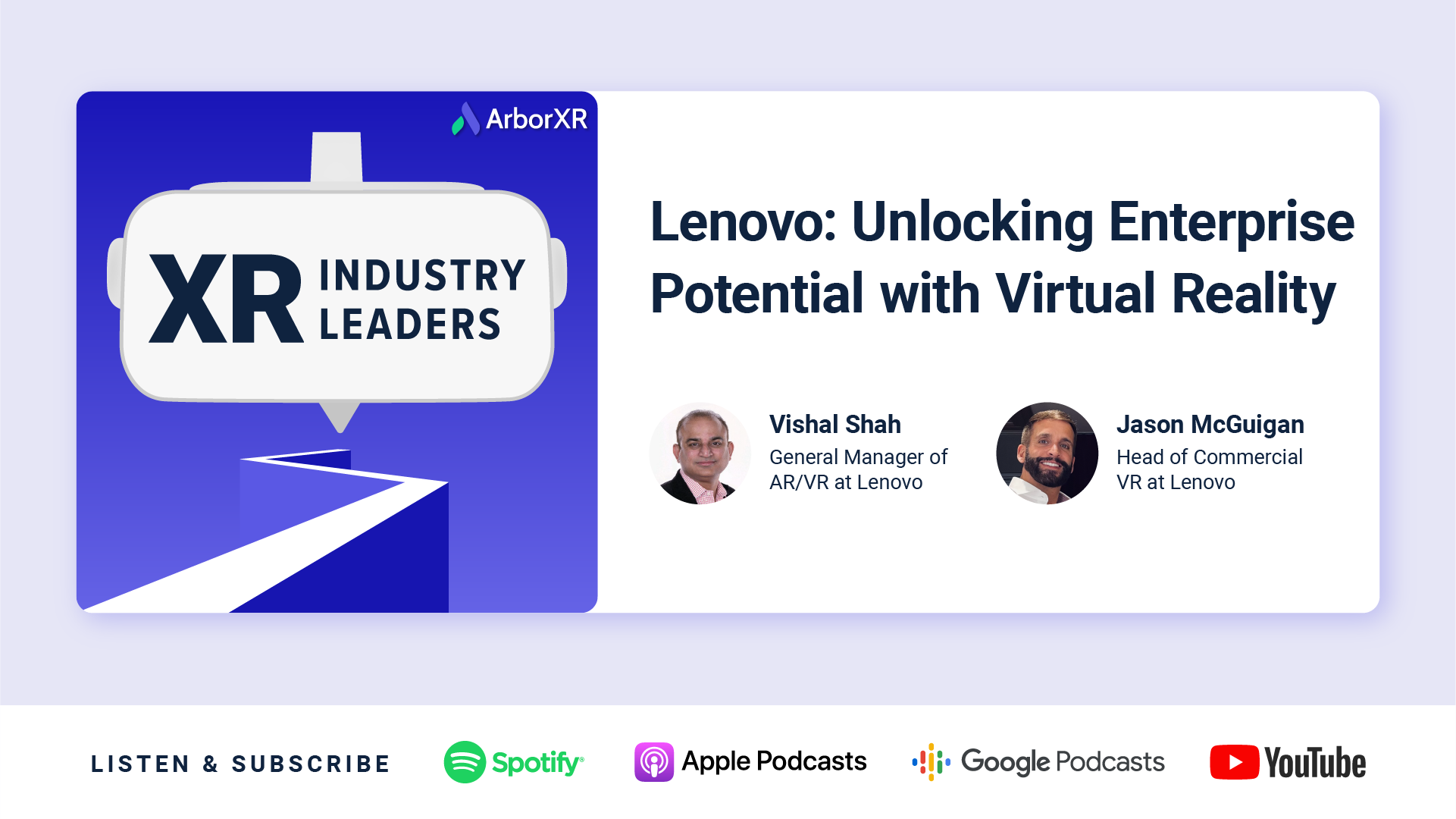
Lenovo: Unlocking Enterprise Potential with VR
Dive into the dynamic world of extended reality (XR) with Lenovo’s Vishal Shah and Jason McGuigan as they unravel Lenovo’s new enterprise XR solution: the Lenovo ThinkReality VRX.

PICO: Practical Enterprise Applications in XR at Scale
Explore XR’s future with PICO’s Amir Khorram in XR Industry Leaders. Insightful discussion on VR enterprise solutions, partnerships, and industry adoption.
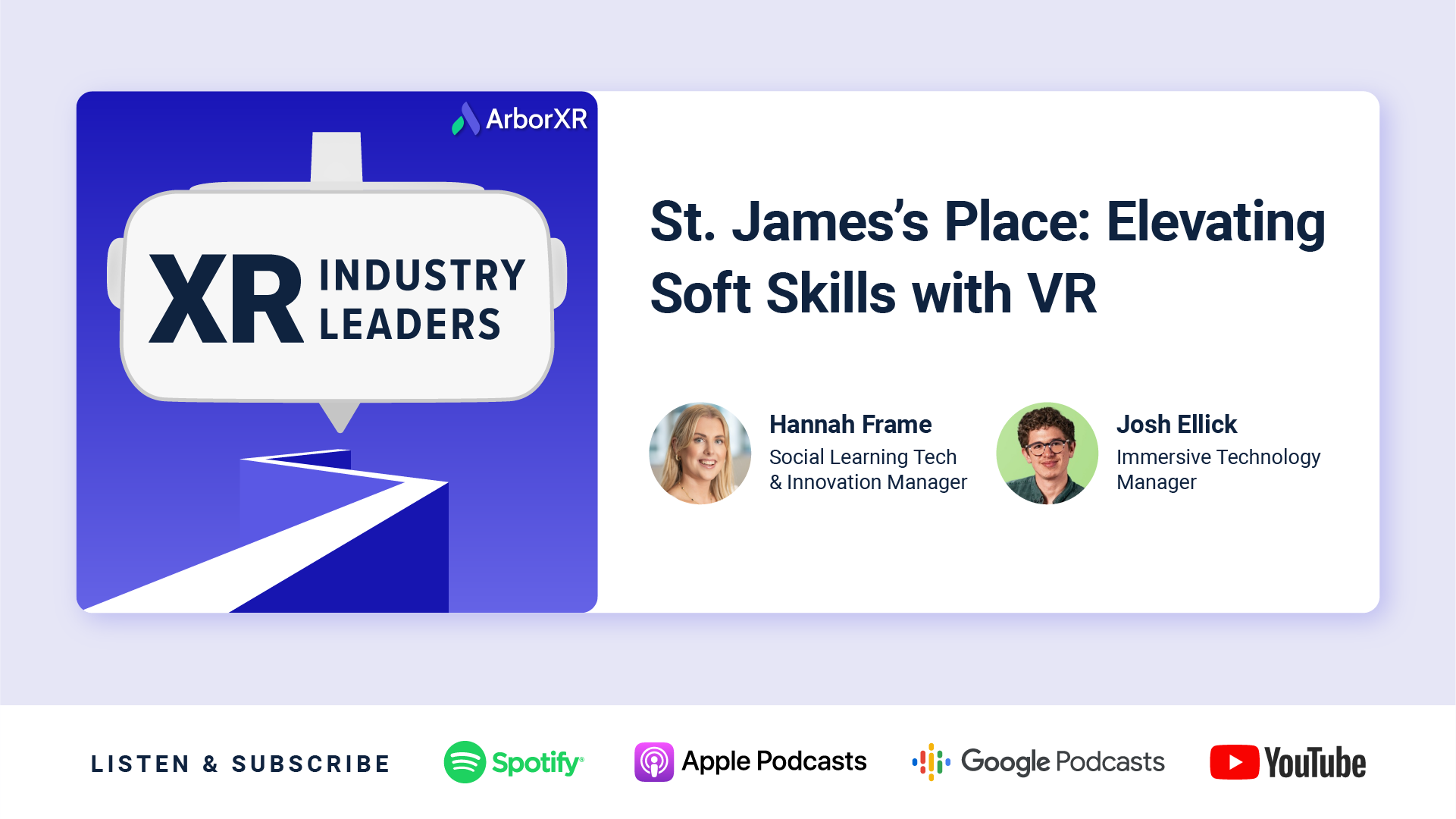
St. James’s Place: Elevating Soft Skills with VR
Hannah & Josh St. James’s Place discuss using VR to train advisor soft skills, challenges of managing headsets at scale, lessons on user adoption, and content development.
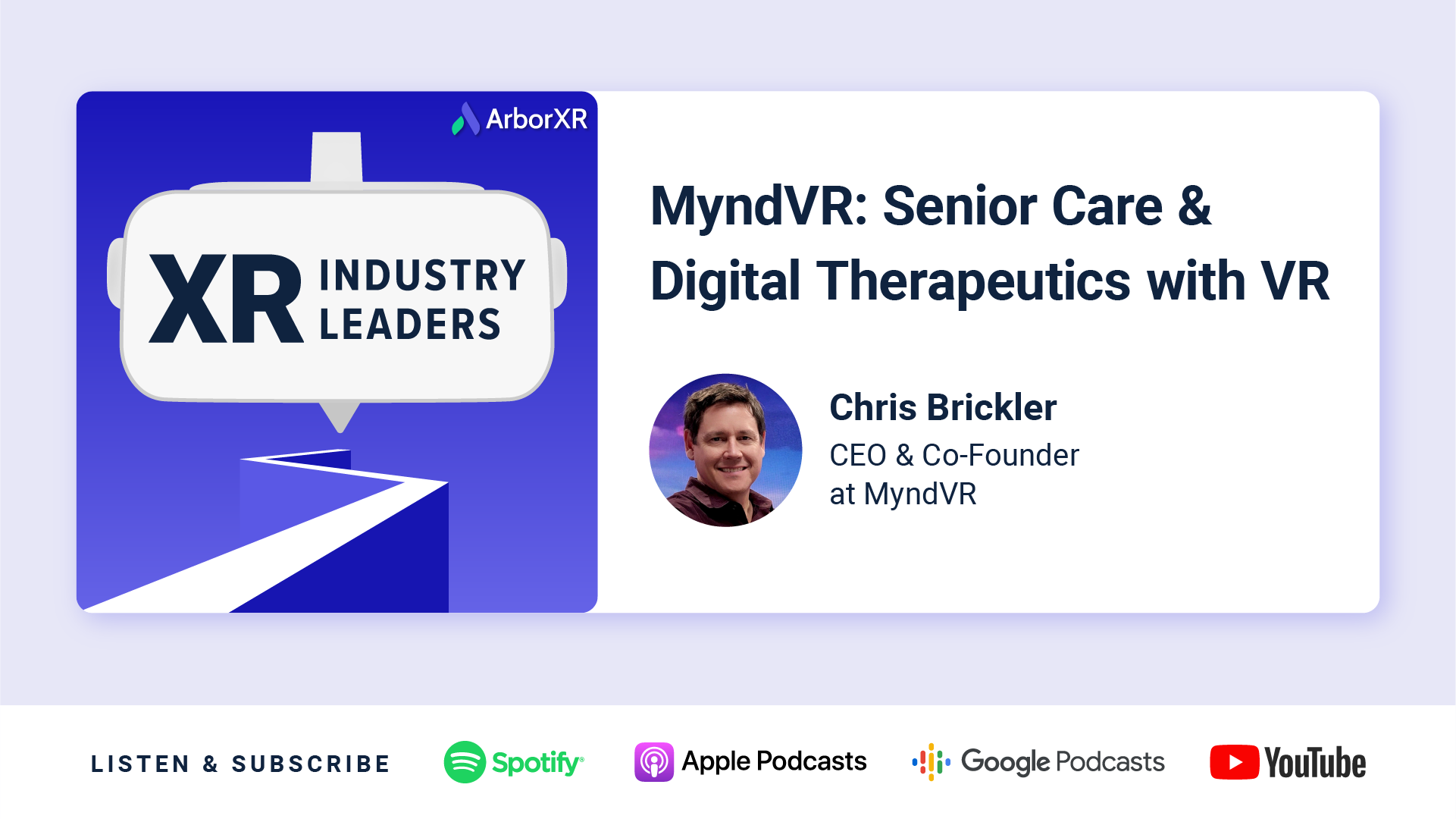
MyndVR: Senior Care and Digital Therapeutics with VR
Chris Brickler shares how VR therapy improves memories and care for elderly patients, and the challenges of scaling VR across health senior care facilities.
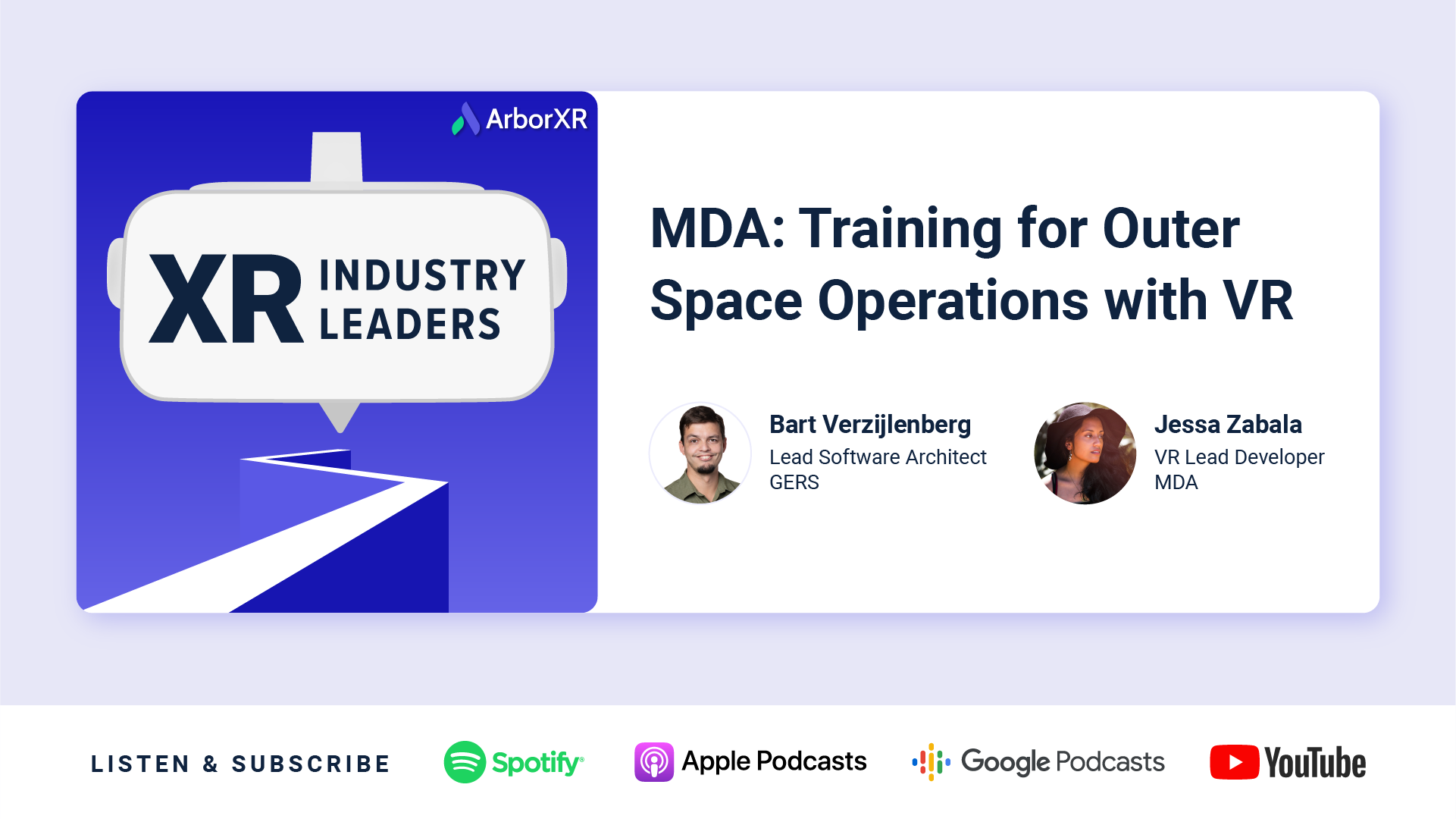
MDA: Training For Outer Space Operations with VR
Discover how MDA leverages VR for astronaut training, mission planning, and onboarding. Gain valuable insights into implementing immersive technologies at scale.

Harvard: Experiential VR Learning in Education
Matt Cook from Harvard joins us to discuss how virtual & augmented reality are redefining higher education through customized immersive experiences.
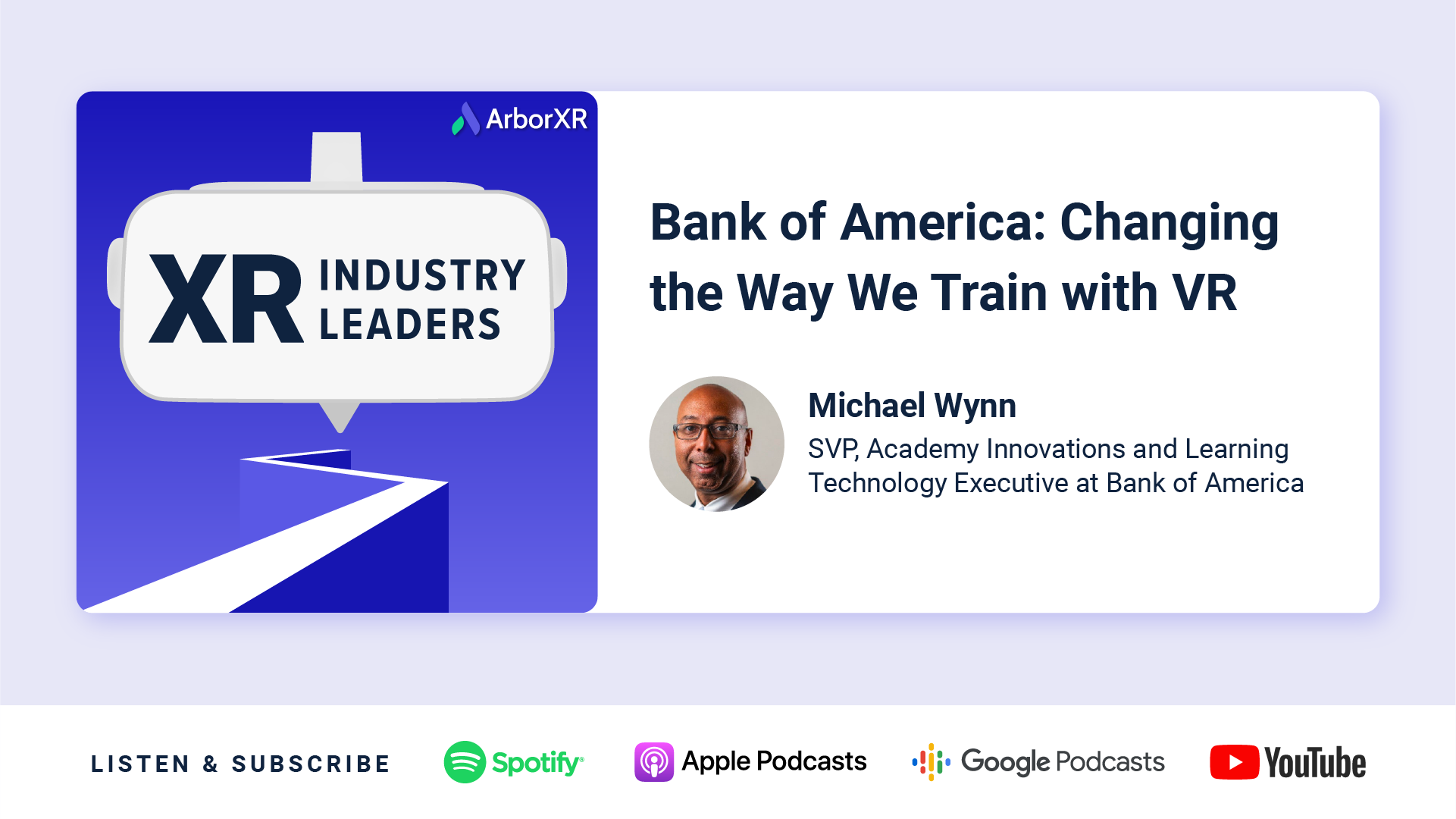
Bank of America: Changing the Way We Train with VR
Explore how Bank of America is revolutionizing training with VR, enhancing employee engagement, overcoming challenges with VR, and redefining corporate education.
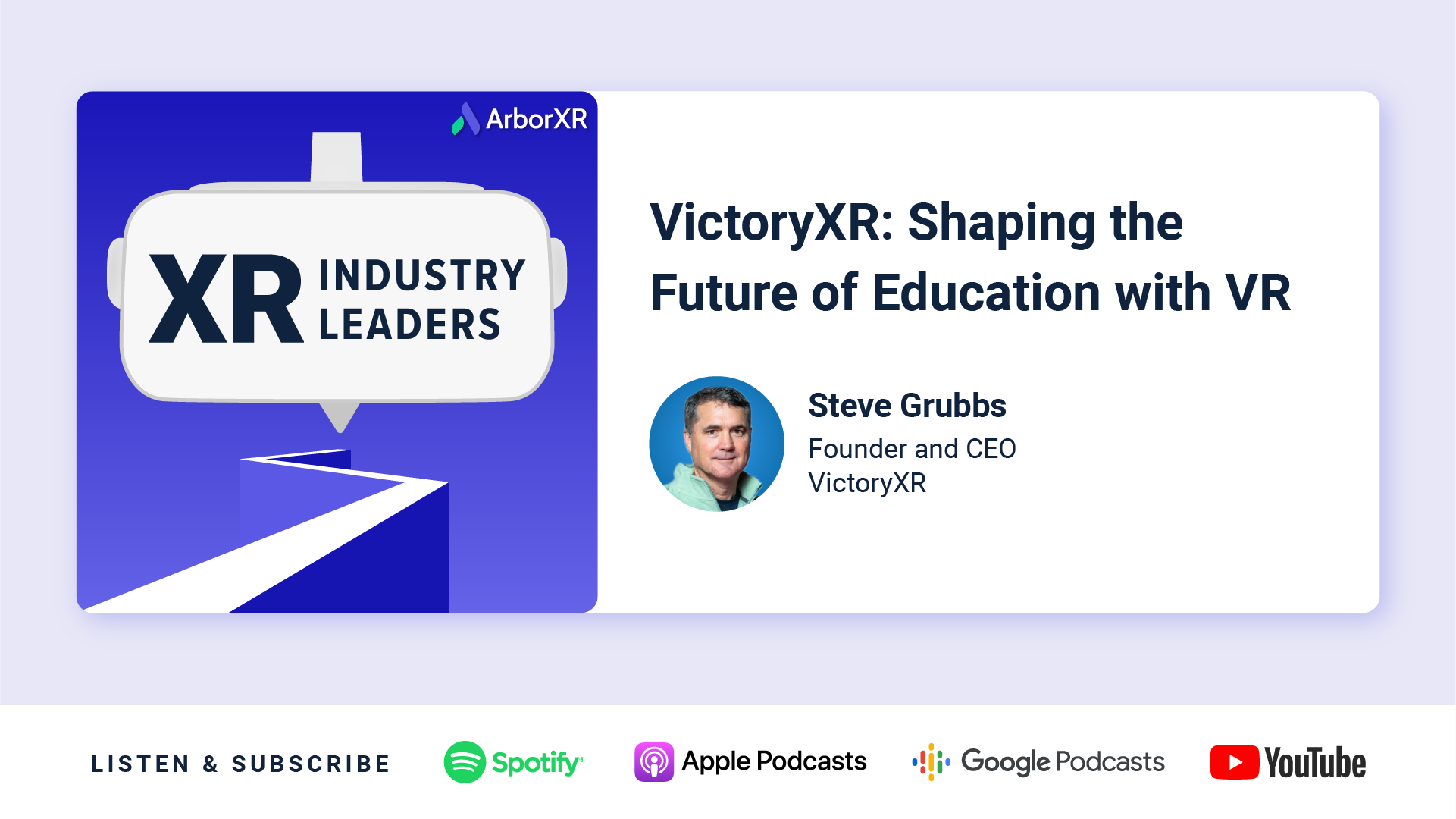
VictoryXR: Shaping the Future of Education with VR
VictoryXR CEO Steve Grubbs discusses creating virtual reality curriculums for education, working closely with Meta, and the future of immersive technology for teachers and students.

VRpatients: Designing Your Own VR Training for Healthcare
Learn how VRpatients creates VR simulations that instructors can customize to give trainees real-life experiences in healthcare.
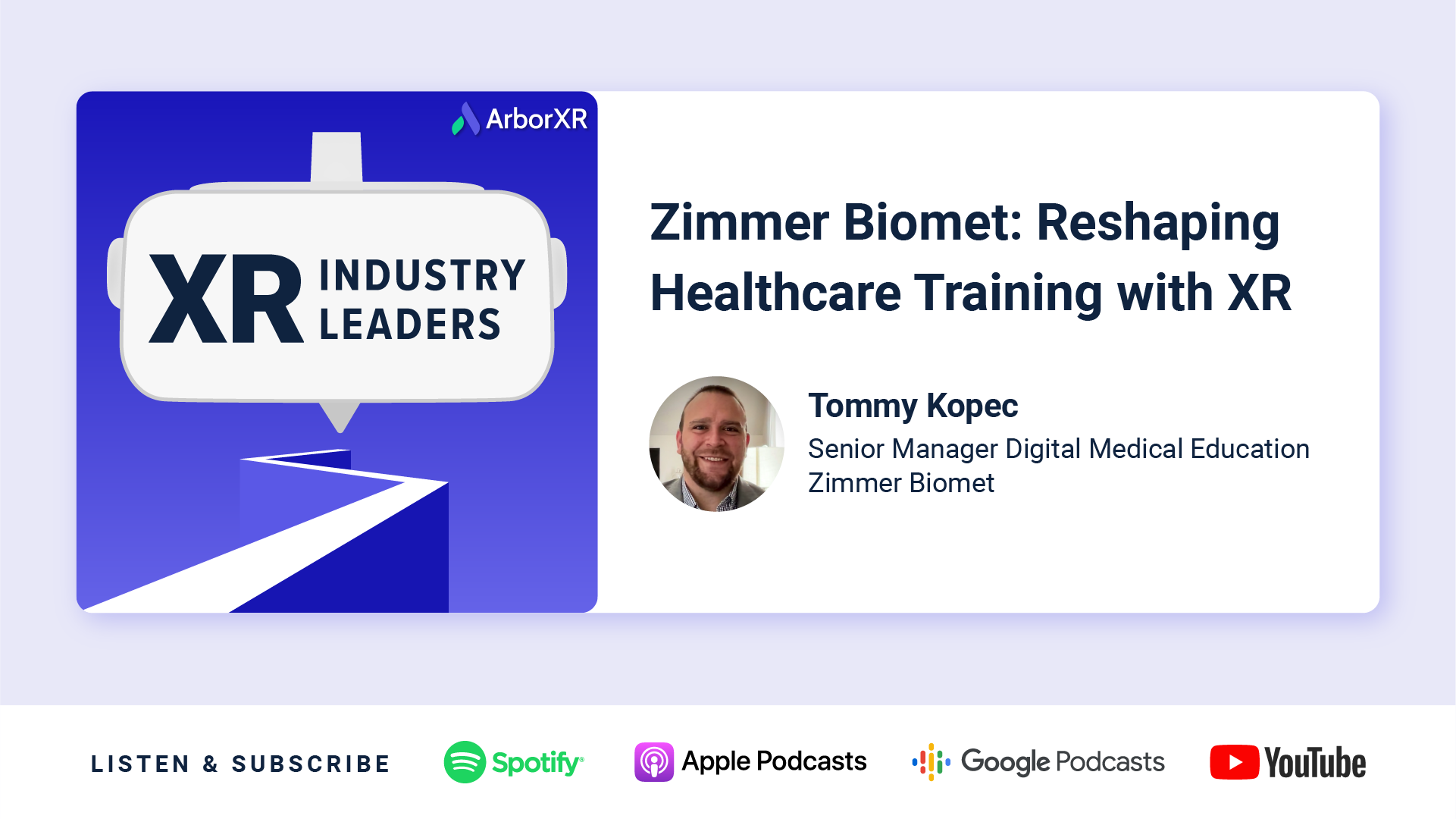
Zimmer Biomet: Reshaping Healthcare Training with AR and VR
If you’re interested in how XR will shape medicine going forward, this is a must-listen episode. Tommy Kopec of Zimmer Biomet provides an insider’s perspective on VR’s transformative potential for surgery, training, and beyond.
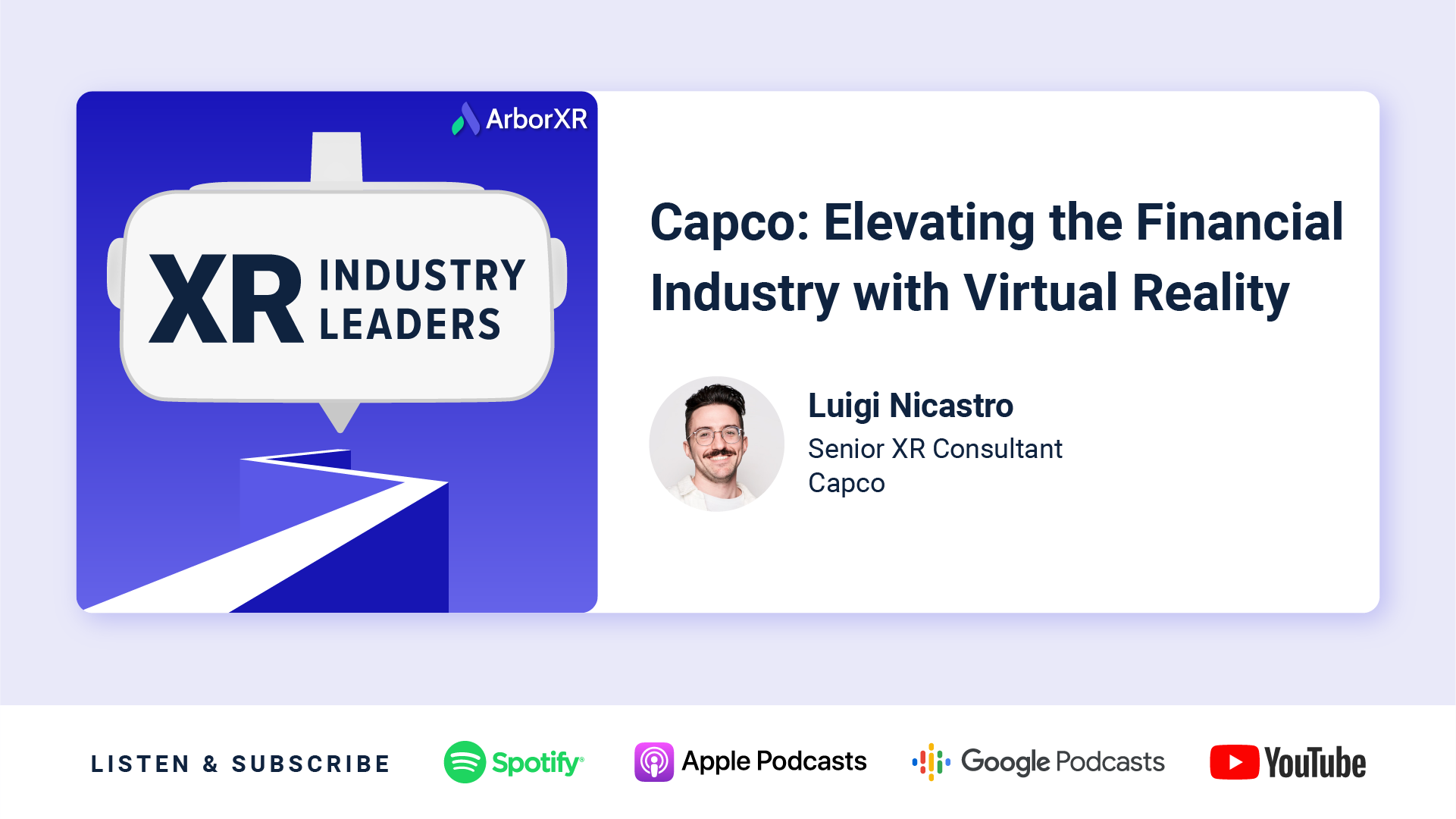
Capco: Elevating the Financial Industry with Virtual Reality
Explore how Capco revolutionizes the financial industry with virtual reality. Discover their success, challenges, and predictions for VR’s impact.

MIT: Exploring Extended Reality in Historic Operas
Discover how MIT uses AR and VR to create immersive experiences for historic operas. We discuss XR in education, challenges and advice for new adopters, and more.

Magic Leap: How Augmented Reality is Elevating Enterprise
Discover how Magic Leap is taking augmented reality to the next level with their enterprise-focused hardware, including real-world statistics and use cases.

Bodyswaps: Innovating Soft Skills Training with Virtual Reality
Discover the future of VR in education with Bodyswaps. Learn how VR elevates soft skills training, and how to implement VR technology effectively.
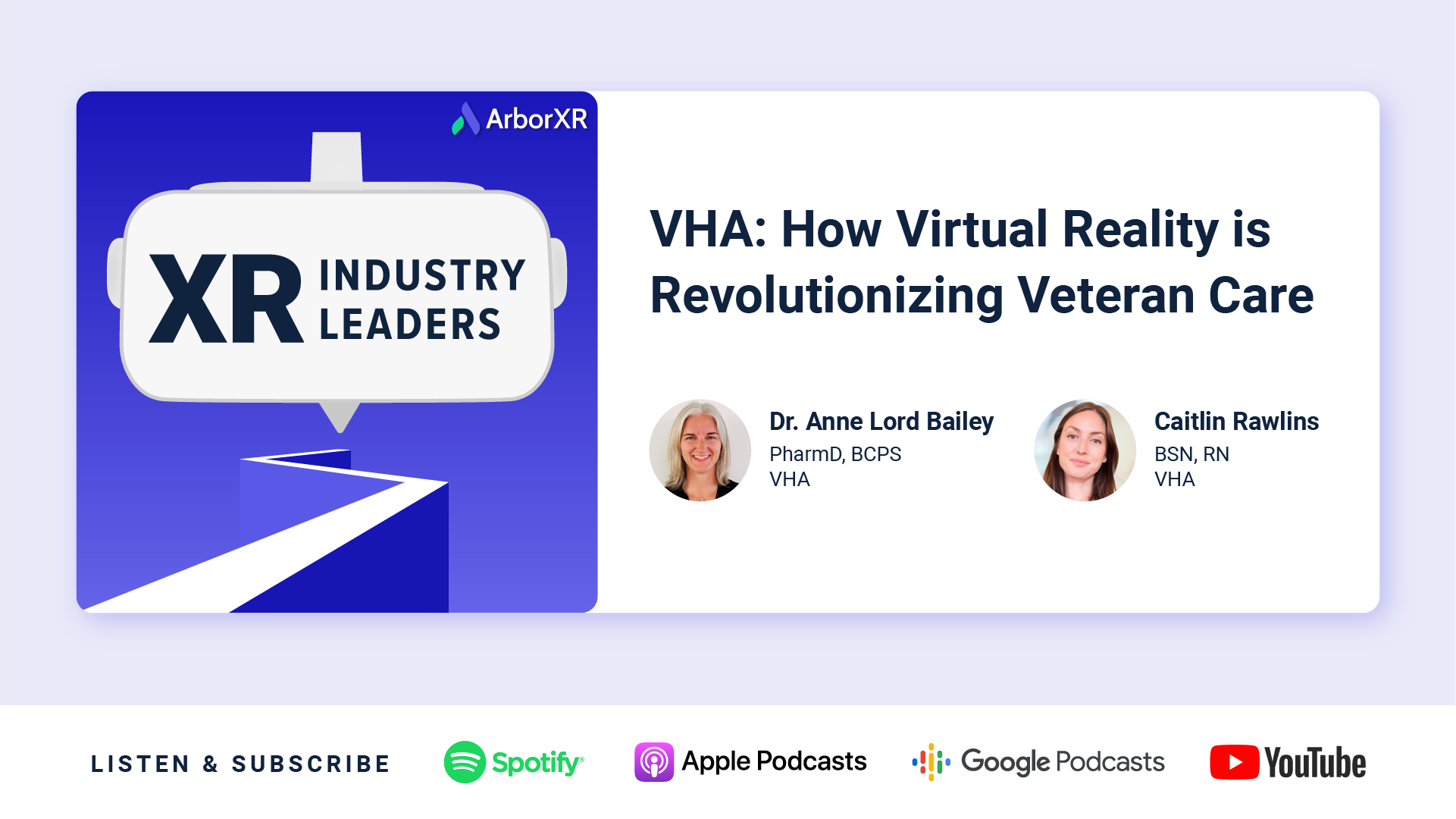
VHA: How Virtual Reality is Revolutionizing Veteran Care
Discover how the VHA is using virtual reality to improve the lives of veterans with pain management, mental health, and overall well-being.
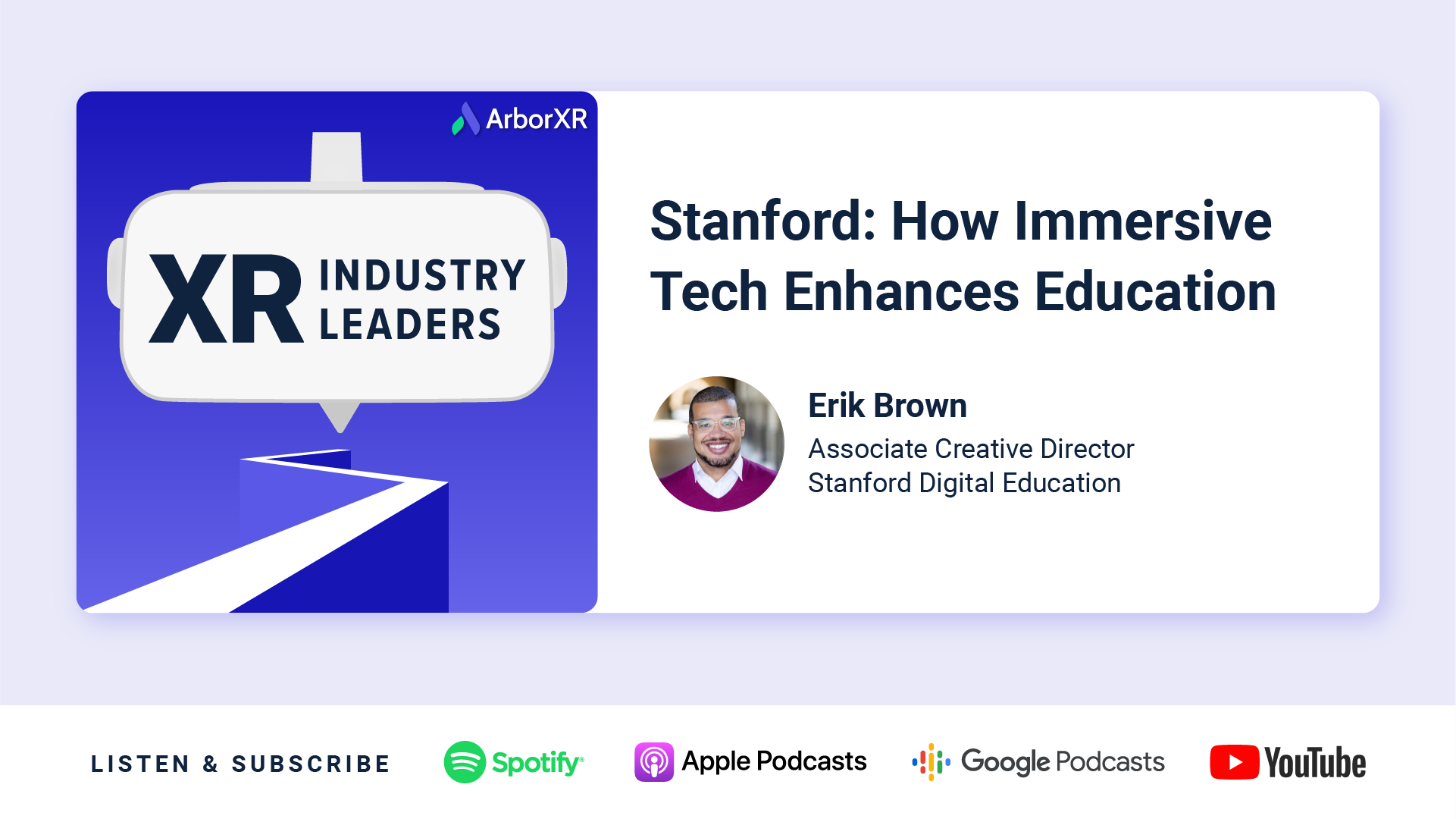
Stanford: How Immersive Technology Enhances Education
Erik Brown discusses how Stanford uses virtual reality for education, empathy in VR, challenges with creating and managing XR content, and more.
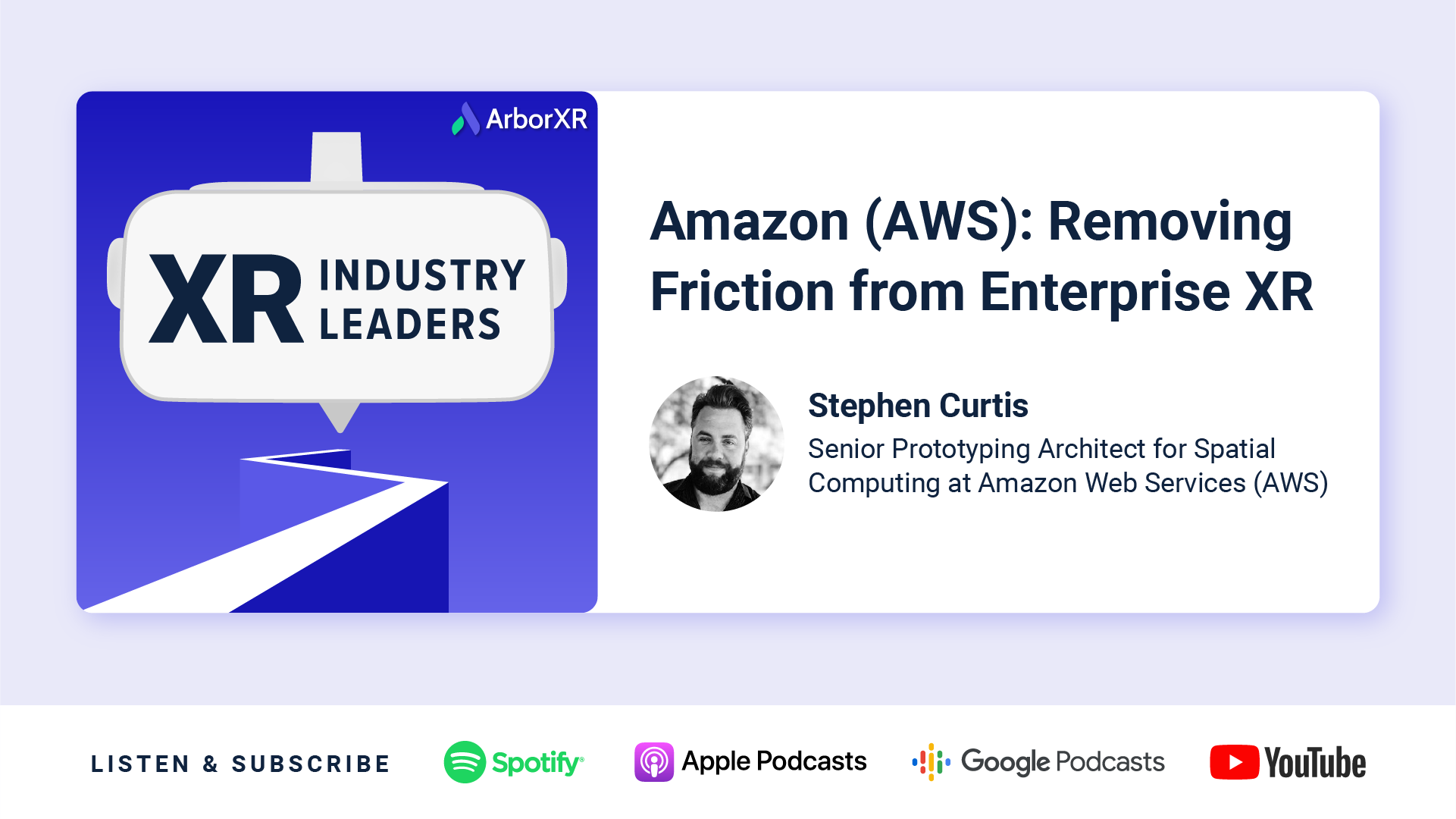
Amazon (AWS): Removing Friction from Enterprise XR
Stephen Curtis from AWS discusses how XR solves enterprise friction, advice for new adopters, XR content authoring, XR device management and more.

WestRock: How XR is Accelerating Manufacturing
XR champion Scott Burkey discusses the impact AR and VR is having on manufacturing, challenges implementing new technology, and advice for using XR in business.

Pfizer: Transforming How We Train with XR
XR leader Nicholas Hockley discusses how XR transformed the way Pfizer trains, challenges with AR/VR content, moving from a pilot program to scale, and more.
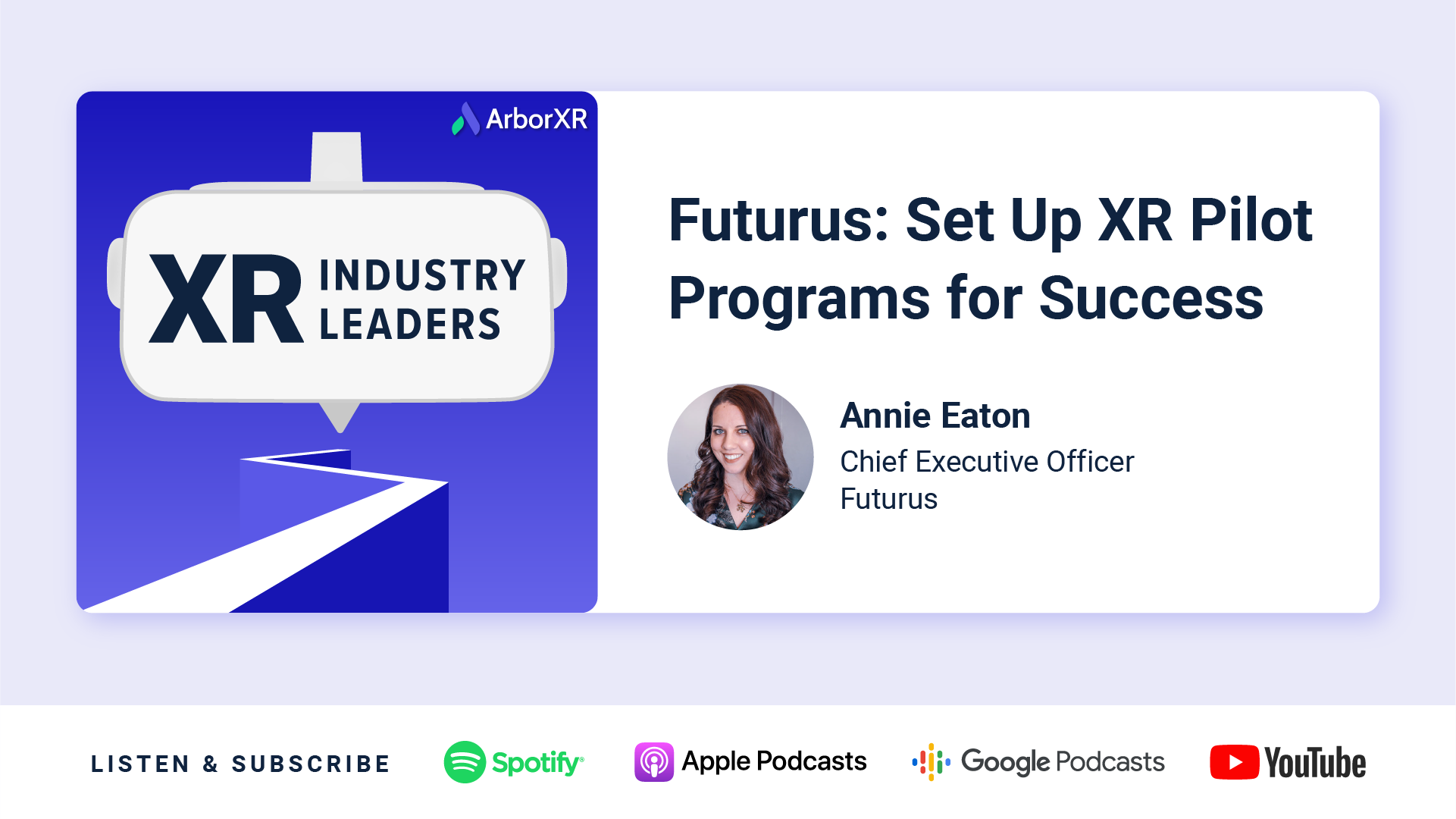
Futurus: Set Up XR Pilot Programs for Success
Futurus CEO Annie Eaton discusses creating AR/VR content, how to set up XR pilot programs for success, challenges in XR, advice for new adopters, and more.
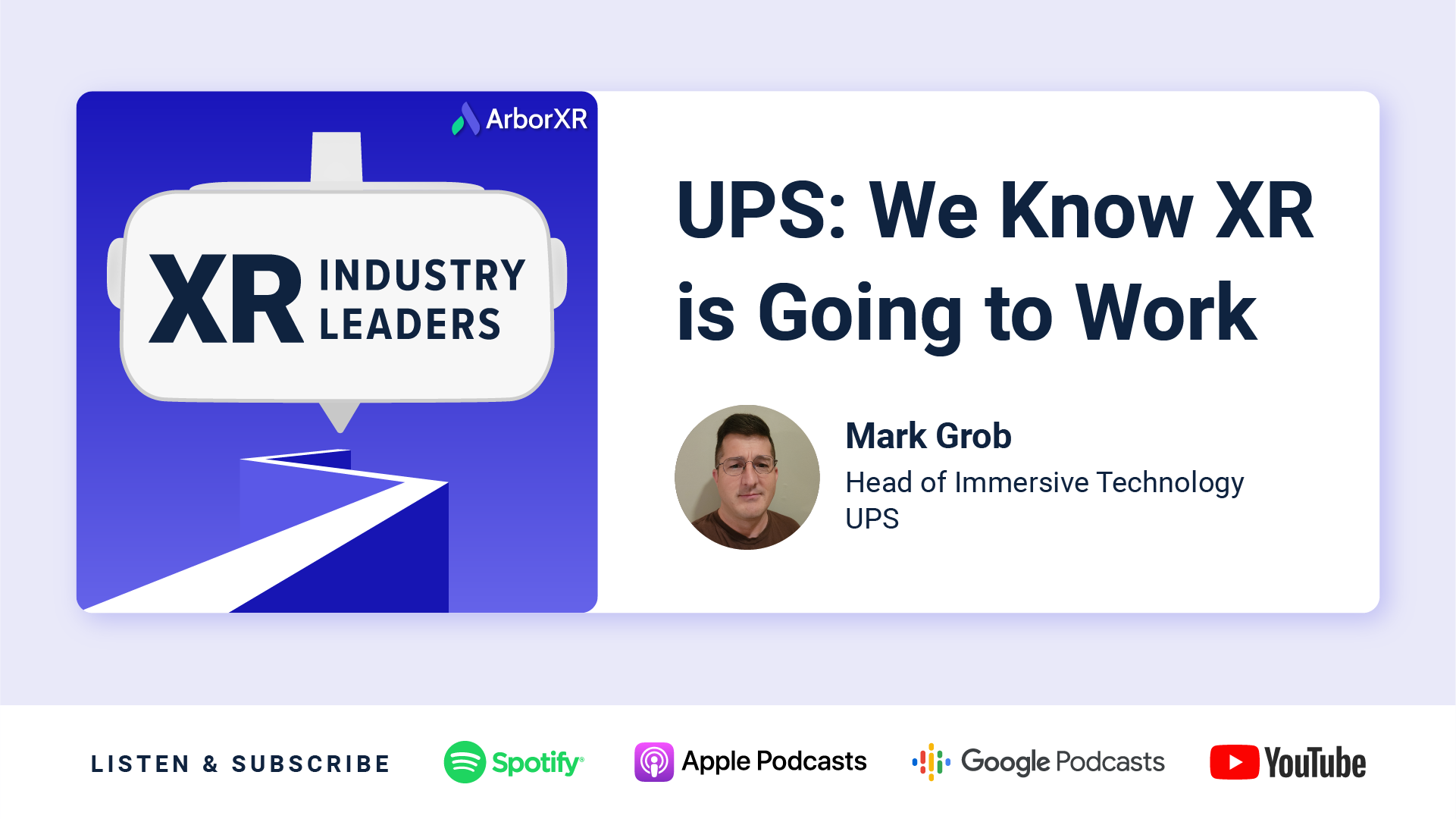
UPS: We Know XR is Going to Work
Learn how UPS built XR training as a practice. We discuss using AR/VR in business, challenges and benefits of XR training, advice for new adopters & more.

INVISTA (Koch Industries): What if We Reimagined Our Entire Training Process?
Learn how XR is transforming INVISTA (Koch). We discuss using AR/VR in business, challenges and benefits of XR training, strategy to scaling XR adoption & more.

Lenovo: Unlocking Enterprise Potential with VR
Dive into the dynamic world of extended reality (XR) with Lenovo’s Vishal Shah and Jason McGuigan as they unravel Lenovo’s new enterprise XR solution: the Lenovo ThinkReality VRX.

PICO: Practical Enterprise Applications in XR at Scale
Explore XR’s future with PICO’s Amir Khorram in XR Industry Leaders. Insightful discussion on VR enterprise solutions, partnerships, and industry adoption.

St. James’s Place: Elevating Soft Skills with VR
Hannah & Josh St. James’s Place discuss using VR to train advisor soft skills, challenges of managing headsets at scale, lessons on user adoption, and content development.

MyndVR: Senior Care and Digital Therapeutics with VR
Chris Brickler shares how VR therapy improves memories and care for elderly patients, and the challenges of scaling VR across health senior care facilities.

MDA: Training For Outer Space Operations with VR
Discover how MDA leverages VR for astronaut training, mission planning, and onboarding. Gain valuable insights into implementing immersive technologies at scale.

Harvard: Experiential VR Learning in Education
Matt Cook from Harvard joins us to discuss how virtual & augmented reality are redefining higher education through customized immersive experiences.

Bank of America: Changing the Way We Train with VR
Explore how Bank of America is revolutionizing training with VR, enhancing employee engagement, overcoming challenges with VR, and redefining corporate education.

VictoryXR: Shaping the Future of Education with VR
VictoryXR CEO Steve Grubbs discusses creating virtual reality curriculums for education, working closely with Meta, and the future of immersive technology for teachers and students.

VRpatients: Designing Your Own VR Training for Healthcare
Learn how VRpatients creates VR simulations that instructors can customize to give trainees real-life experiences in healthcare.

Zimmer Biomet: Reshaping Healthcare Training with AR and VR
If you’re interested in how XR will shape medicine going forward, this is a must-listen episode. Tommy Kopec of Zimmer Biomet provides an insider’s perspective on VR’s transformative potential for surgery, training, and beyond.
